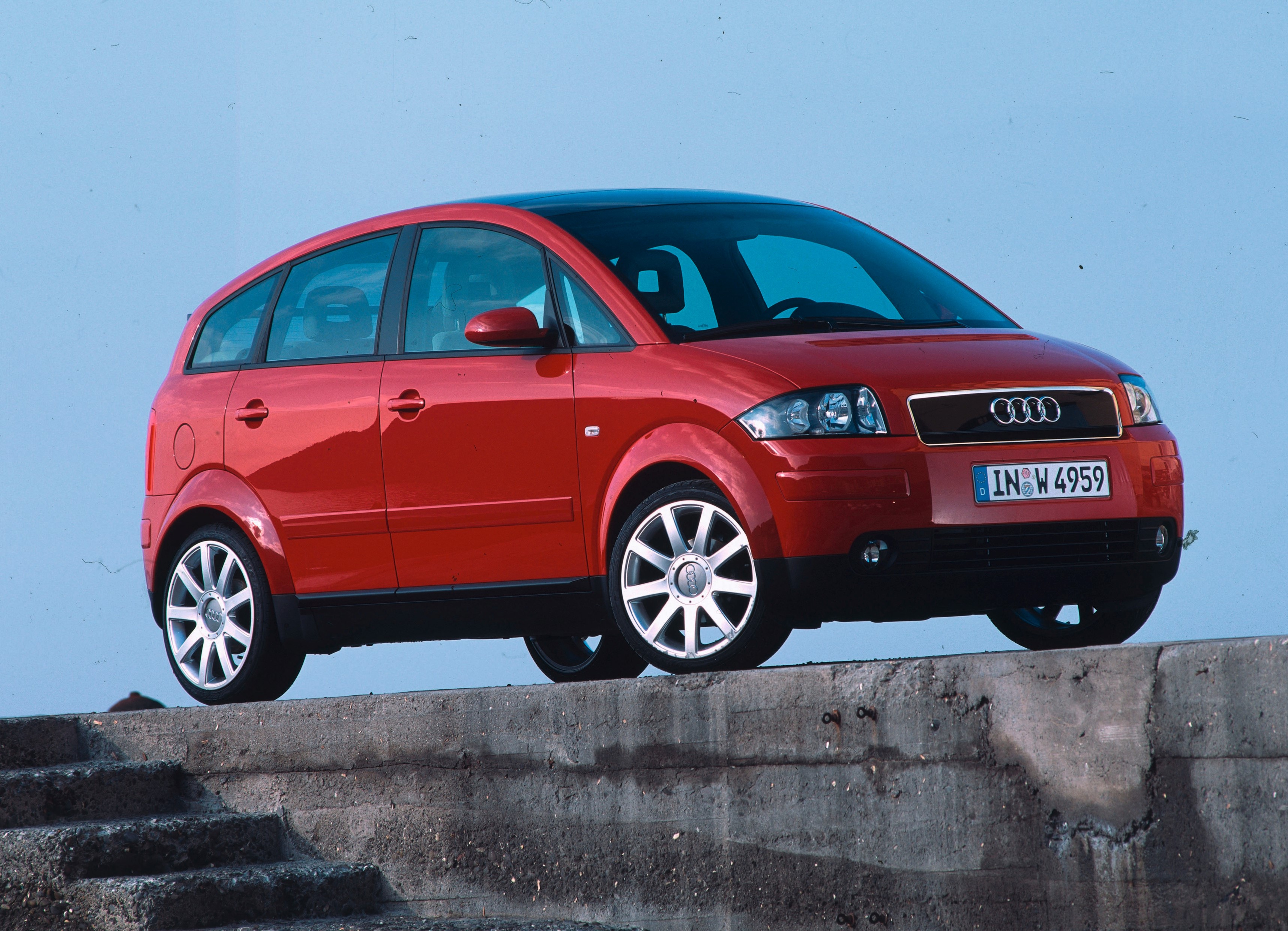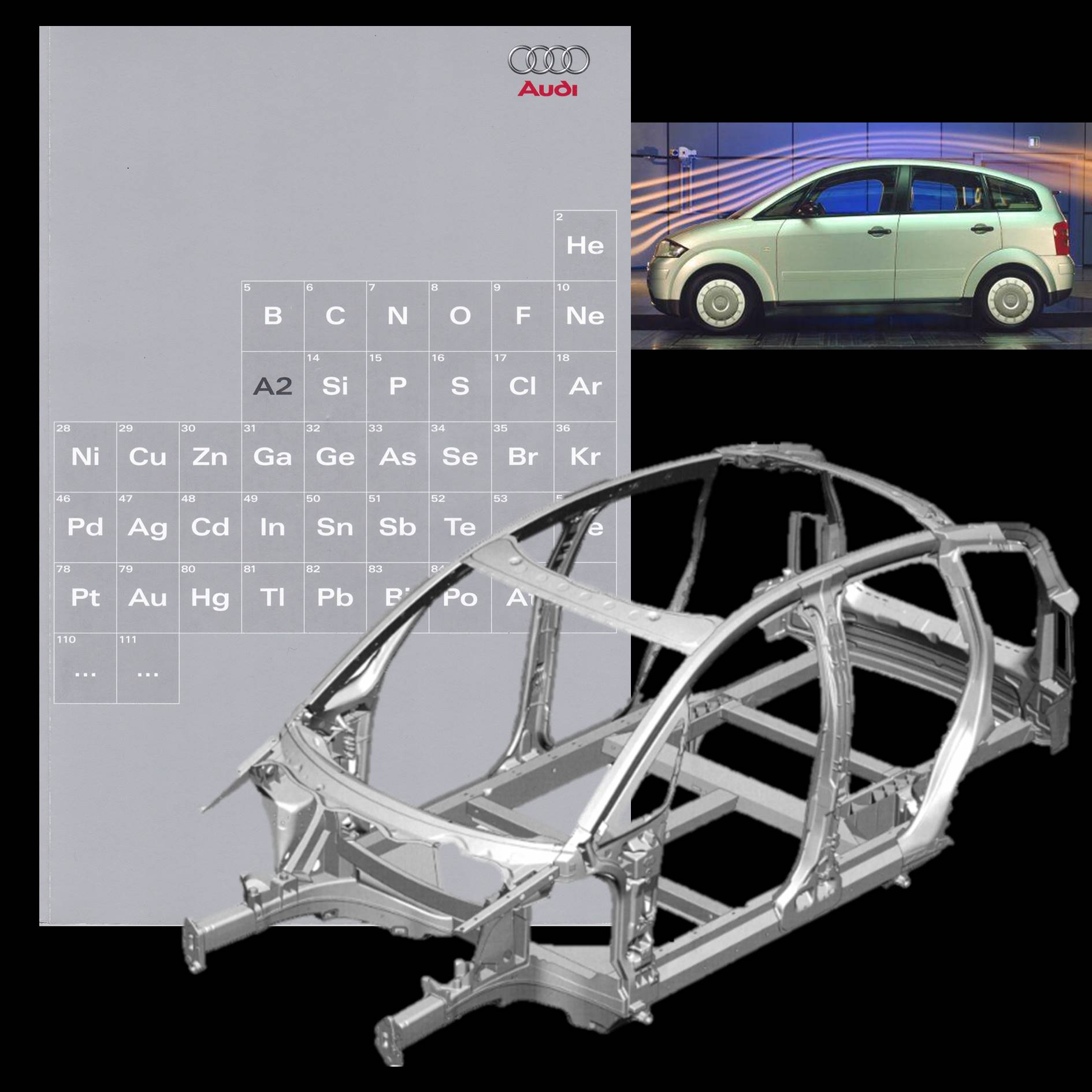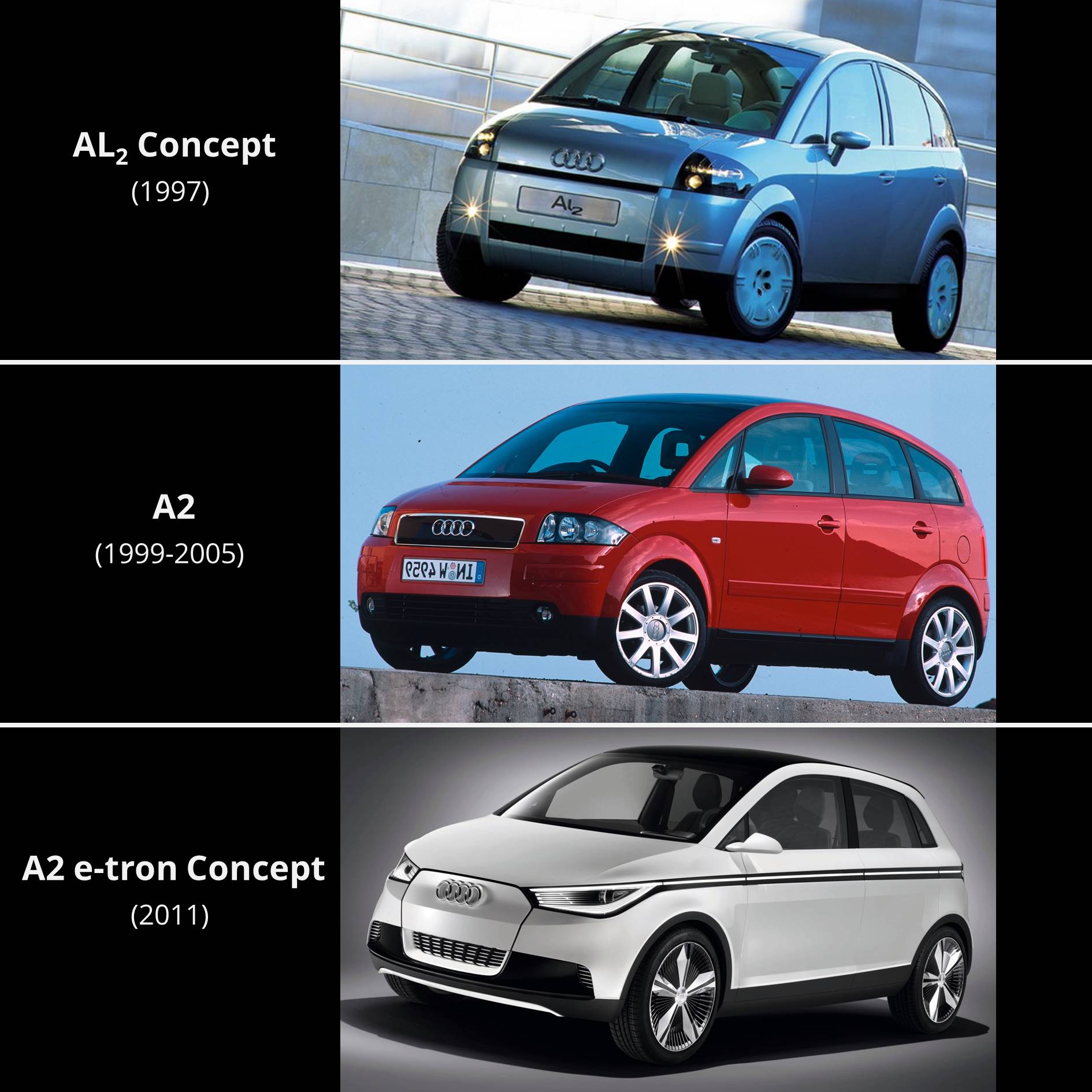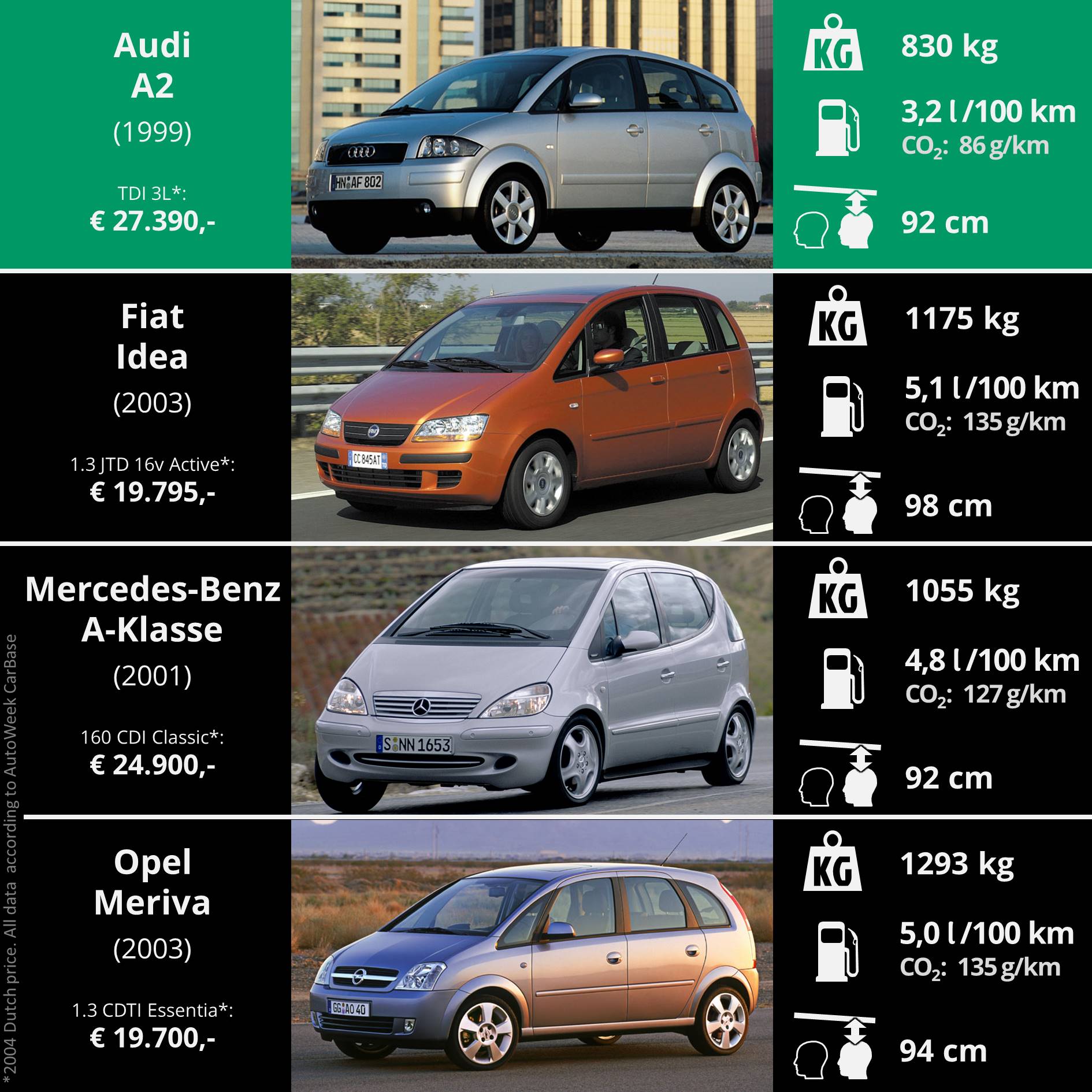MY CLASSICS
Audi A2
Cars
| 28-08-2020
There are many advantages to MPVs; they are called Multi Purpose Vehicles for a reason. However, the concept of the monovolume also has disadvantages, which often have to do with the higher height of those types of cars. For example: a higher weight, more air resistance and higher consumption. The Audi engineers decided to do something about it and outdid themselves.

In order to properly appreciate a solution, you must know the problem. That's why I first go back to two models I discussed earlier: the Renault Mégane Scénic and Fiat Multipla. In all their multifunctional glory, they easily weigh around 200 kg more than their hatchback brothers Mégane and Brava. As a result, the Scénic as RN 1.4e consumes an average of 0.6 liters of petrol more per 100 km than a Mégane RN 1.4e 5-door hatchback. With the Multipla and Brava as 1.6 16V SX, the difference is even 0.8 liters per 100 km. The CO2 emissions of the aforementioned Multipla are therefore 19 grams per kilometer higher. I don't have that data from the Mégane Scénic, but it will probably be comparable. In short: an MPV is higher and heavier, and therefore consumes more fuel and emits more CO2. With that the problem is known. Over to the Audi engineers.

A very simple analysis of the problem shows that there are a number of things that are of influence and therefore are important in finding a solution. The one thats strikes the eye the most is the weight of the car. You can bring that down by using other materials for the construction of the car, and in the late 1990s, Audi happened to already have experience with working with aluminum in their top model, the A8. In that segment, the higher costs of using the lightweight metal are easier to recover, so that's a logical starting point for such an innovation. In the segment in which the A2 would operate, that's quite a bit harder, but fortunately that didn't stop Audi. To warm up the audience and to make them aware of the fact that the new Benjamin has an aluminum spaceframe as construction, Audi came up with the AL2 Concept in 1997. And on the cover of the Dutch brochure they put the periodic table of elements, with the name of the model where it usually says aluminum (Al): A2. The result of using aluminum is impressive: an A2 with 1.4 petrol engine weighs only 895 kg. For comparison: the slightly smaller Mercedes-Benz A-Class with 1.4 petrol engine weighs 1020 kilograms, a difference of 125 kg. That's well begun, but only done for a third.

The weight of a car is not the only thing that affects fuel consumption. An important other factor is the resistance the car has to overcome in order to move forward, including air resistance. Because MPVs are higher than bodies such as hatchbacks and sedans, they catch more wind. This can be partly overcome by making the car more drop-shaped. That's why MPVs often have a more slanted windscreen and an extra side window in front of the front door. Furthermore, it helps to make the nose round and smooth, with not too many openings interfering with the airflow, and a sloping roof also helps to reduce the drag coefficient. That is why the A2 has a service hatch where the grille is usually located. The A2 also has a steeply sloping roofline, very steeply even. To ensure that the rear occupants still have enough headroom, Audi uses the double floor the A2 has: there's a cut-away for the rear passengers to place their feet, so the seats can be lower than in other cars. Lower weight: check. Lower air resistance: check. On to the third subsolution.

With the introduction (in the Netherlands in the year 2000) of the A2, Audi offered a choice of two engines: a 1.4 petrol and a 1.4 TDI diesel engine. Both engines delivered 75 hp (55 kW), but the diesel naturally had more pulling power. Despite the fact that the diesel version weighed slightly more (990 against 895 kg), the consumption was lower than with the petrol version. The same was true for CO2 emissions. The petrol averaged 6.0 liters/100 km and emitted 144 g/km of CO2, against 4.3 liters/100 km and 116 g/km with the diesel. At the time, Audi was a strong advocate for diesel engines in achieving lower emissions figures, and rightly so, as these figures show. In 2001 the brand even took it a step further, when the A2 became available as 1.2 TDI 3L. That '3L' stands for the average consumption of 3 liters/100 km; that's 1 in 33.3! A promising development and good for the image of diesel engines – which makes it extra harsh that Audi played a key role in the diesel scandal not much later. This however doesn't alter the fact that the brand launched a highly innovative compact car with the A2. Perhaps a bit too innovative, because the A2 was considerably more expensive than its less progressive competitors. In 2011, the A2 seemed to get an electrically powered sequel six years after the production stop, but to date, that A2 e-tron hasn't made it to the dealerships – and I don't think that's ever going to happen. Innovation is a beautiful thing that I can really get a kick out of. Unfortunately, if the customer doesn't want to pay for it, than that's the end of it…


Audi A2
The problemIn order to properly appreciate a solution, you must know the problem. That's why I first go back to two models I discussed earlier: the Renault Mégane Scénic and Fiat Multipla. In all their multifunctional glory, they easily weigh around 200 kg more than their hatchback brothers Mégane and Brava. As a result, the Scénic as RN 1.4e consumes an average of 0.6 liters of petrol more per 100 km than a Mégane RN 1.4e 5-door hatchback. With the Multipla and Brava as 1.6 16V SX, the difference is even 0.8 liters per 100 km. The CO2 emissions of the aforementioned Multipla are therefore 19 grams per kilometer higher. I don't have that data from the Mégane Scénic, but it will probably be comparable. In short: an MPV is higher and heavier, and therefore consumes more fuel and emits more CO2. With that the problem is known. Over to the Audi engineers.

The space frame of the A2, with behind it the front of the Dutch brochure and a photo of the A2 in a wind tunnel test
Subsolution 1: aluminumA very simple analysis of the problem shows that there are a number of things that are of influence and therefore are important in finding a solution. The one thats strikes the eye the most is the weight of the car. You can bring that down by using other materials for the construction of the car, and in the late 1990s, Audi happened to already have experience with working with aluminum in their top model, the A8. In that segment, the higher costs of using the lightweight metal are easier to recover, so that's a logical starting point for such an innovation. In the segment in which the A2 would operate, that's quite a bit harder, but fortunately that didn't stop Audi. To warm up the audience and to make them aware of the fact that the new Benjamin has an aluminum spaceframe as construction, Audi came up with the AL2 Concept in 1997. And on the cover of the Dutch brochure they put the periodic table of elements, with the name of the model where it usually says aluminum (Al): A2. The result of using aluminum is impressive: an A2 with 1.4 petrol engine weighs only 895 kg. For comparison: the slightly smaller Mercedes-Benz A-Class with 1.4 petrol engine weighs 1020 kilograms, a difference of 125 kg. That's well begun, but only done for a third.

Three times Audi A2: the AL2 Concept, the production model and the A2 e-tron Concept
Subsolution 2: aerodynamicsThe weight of a car is not the only thing that affects fuel consumption. An important other factor is the resistance the car has to overcome in order to move forward, including air resistance. Because MPVs are higher than bodies such as hatchbacks and sedans, they catch more wind. This can be partly overcome by making the car more drop-shaped. That's why MPVs often have a more slanted windscreen and an extra side window in front of the front door. Furthermore, it helps to make the nose round and smooth, with not too many openings interfering with the airflow, and a sloping roof also helps to reduce the drag coefficient. That is why the A2 has a service hatch where the grille is usually located. The A2 also has a steeply sloping roofline, very steeply even. To ensure that the rear occupants still have enough headroom, Audi uses the double floor the A2 has: there's a cut-away for the rear passengers to place their feet, so the seats can be lower than in other cars. Lower weight: check. Lower air resistance: check. On to the third subsolution.

The A2 compared to three competitors
Subsolution 3(L): dieselWith the introduction (in the Netherlands in the year 2000) of the A2, Audi offered a choice of two engines: a 1.4 petrol and a 1.4 TDI diesel engine. Both engines delivered 75 hp (55 kW), but the diesel naturally had more pulling power. Despite the fact that the diesel version weighed slightly more (990 against 895 kg), the consumption was lower than with the petrol version. The same was true for CO2 emissions. The petrol averaged 6.0 liters/100 km and emitted 144 g/km of CO2, against 4.3 liters/100 km and 116 g/km with the diesel. At the time, Audi was a strong advocate for diesel engines in achieving lower emissions figures, and rightly so, as these figures show. In 2001 the brand even took it a step further, when the A2 became available as 1.2 TDI 3L. That '3L' stands for the average consumption of 3 liters/100 km; that's 1 in 33.3! A promising development and good for the image of diesel engines – which makes it extra harsh that Audi played a key role in the diesel scandal not much later. This however doesn't alter the fact that the brand launched a highly innovative compact car with the A2. Perhaps a bit too innovative, because the A2 was considerably more expensive than its less progressive competitors. In 2011, the A2 seemed to get an electrically powered sequel six years after the production stop, but to date, that A2 e-tron hasn't made it to the dealerships – and I don't think that's ever going to happen. Innovation is a beautiful thing that I can really get a kick out of. Unfortunately, if the customer doesn't want to pay for it, than that's the end of it…

The A2 inspired me to draw a Peugeot variant, which I called 'A206'. My sketch for a new A2, above, is from a later date
MY CLASSICS
In the My classics section, I regularly add a model to my digital collection of classics. For that, I select cars whose design appeals to me or evokes memories. So nostalgia, and very subjective. Hence the section title: my classics.
Sources
- Dutch brochure about the Audi A2 (Audi AG - 033/1101.50.33 - Valid from 02.03.2000).
- AutoWeek CarBase
- The images (on this page and in the related posts on my Instagram account) come from the sources mentioned and from the following websites: Audi Media Center, oldconceptcars.com, audia2museum.de, audiworld.com, Mercedes-Benz en Peugeot Media.
